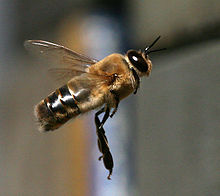Beekeeping/Drone Bee
The drone honeybee is the only male resident within a colony of bees. At the beginning of a spring season their population is often below one hundred, with a healthy hive often not having a population greater than a thousand. A good approximation dictates that about 15% of the hive's population is made up of drones. The drone is often described as simply being a fat, lazy bee that is unable to care for himself.

Appearance edit
Those unfamiliar with distinguishing the sexes of bees many often mistake a drone bee as being a queen bee, as he is noticeably different than his sister worker bees. In actuality, the drone bee can be easily distinguished from a queen bee by identifying his large round eyes located close together at the top of his head. The drone’s body shape is also more cylindrical than that of the thinner tapering queen’s body. Though not obviously apparent from casual observation, drone bees also do not have pollen baskets, stingers or wax glands.
Behavior edit
Beg, Borrow and Steal edit
The drone has a reputation for being fat and lazy, this likely comes across due to his manner within the hive. The drone will not help out in brood rearing, comb building, honey curing or storage. Rather the drone does little more than eat. In fact when possible, the drone will beg nurse bees to feed them, when unsuccessful a drone will eventually help himself to stored nourishment. The drone is likely only tolerated within the colony as he is needed to spread the hive’s genetics.
Leaving the Hive edit
In about six days after emerging as a bee, the drone will begin to leave the colony. This however depends on the weather and time of year. As they mature, they will begin to congregate in areas where other drones exist, in hopes of mating with a viable queen.
Kicked Out edit
As the outside weather cools, and mating season comes to an end, most drones that managed to survive unmated will be kicked out of the hive. Drones are a tremendous drain on resources, and are not required for the overwintering process. It is also not uncommon for both adult and brood drone to be kicked out of the hive during a dearth in food collection.
From Egg to Bee edit
Eggs edit
Drones are the result of unfertilized egg and the process of parthenogenesis. Normally, a queen bee will purposely deposit an unfertilized egg into a slightly larger drone cell. A special case also exists where a laying worker bee may deposit eggs into any brood cell.
Larval Diet edit
After hatching into a larval form, drones begin to eat a mixture of worker jelly, pollen and honey. This food has been called drone jelly, though all beekeepers and researchers have not adopted this term.
Drone Cell edit
Most commonly, drone eggs are deposited in what is known as a drone cell. These cells are similar to worker cells, but are wider. After about six days, the drone larva, within the drone cell is capped. These drone cells can easily be distinguished from worker cells once they their capping is domed shaped and protrude beyond other brood cells.
Duties edit
Mating edit
The drone has only one purpose, after completion of which, he will quickly die. The drone honeybee exists to mate. Once mature, the drone leaves his colony to join other drones within designated mating grounds called drone congregation areas. If the drone is successful, mating will occur somewhere around two hundred feet in the air. Because of the fact that his mating apparatus is barbed, much like the stinger of a worker, it will be ripped from his body after mating, and he will fall towards the earth with the only possible outcome of death.
Warmth edit
It is debated by some, that drone bees may also provide insulation to a hive, making it easier to maintain warmth. If anything this function is incidental, and can likely be more efficiently achieved by worker bees.
Life Cycle edit
- Day 0
- An unfertilized egg is laid by either the queen bee or a laying worker.
- Day 3
- The unfertilized egg hatches.
- Day 11
- The drone cell is capped.
- Day 15
- Metamorphosis in to a pupa is complete
- Day 24
- Adult drone emerges.
- Day 30
- The drone begins to leave the colony
- Day 85-06
- The drone dies, if survived unmated
Quick Facts edit
- Many beginning beekeepers practice on drones when learning how to successfully mark the queen, as they do not have stingers, and are not vital to the colony if accidentally injured or even killed.